Types of Fire Extinguishers and How to Use Them Effectively

A fire extinguisher can be the difference between saving your home and a total loss. However, if you’re unfamiliar with fire extinguishers or their proper usage, it may be easy to make mistakes that could cause harm. Read on to learn about the different types of fire extinguishers and how to use them effectively. You can also find tips on how to prevent fires in the first place and how to obtain the right type of home insurance to cover damage from a fire.
The most common type of fire extinguisher is a dry chemical foam or powder. These extinguishers contain sodium bicarbonate (normal baking soda), potassium bicarbonate, or monoammonium phosphate, which decompose when exposed to heat and release carbon dioxide, which helps to smother the fire. These types of extinguishers are most effective on class A fires, which are fueled by solid combustibles such as wood, paper and cloth.
Another type of fire extinguisher is an aqueous film-forming foam (AFFF) extinguisher. Previously available as a “solid charge” model, which housed an external AFFF concentrate cartridge, these units discharged the foam by applying pressure to the hose nozzle. AFFF extinguishers are effective on class B and class C fires, which are fueled by flammable liquids and electrical hazards such as faulty appliances and wiring.
Most fire extinguishers are rated to handle classes A, B and C. If you’re unsure which fire extinguisher to purchase, choose one labeled A-B-C as it is appropriate for most household fires. If you live in a high-rise building, you’ll want to have a class B extinguisher on hand as well.
Make sure the fire extinguisher is in good working order before using it. Check that the can, hoses and nozzle are not damaged or clogged with dust, dirt or oil. If you have a hand-held extinguisher, test it by pulling the pin to break the tamper seal, then aim it low and sweep it across the fire.
After using a fire extinguisher, stand several feet back from the area until it’s safe to return and check that the fire is out. If it’s not out, you’ll need to sound the alarm and call the fire department so they can inspect the scene and extinguish any remaining flames.
Keep a fire extinguisher in your kitchen, basement, garage and any other rooms where a fire is most likely to occur. Have an escape plan in case you must evacuate during a fire. And don’t forget to install and regularly test working smoke detectors, which are an important part of your home safety system. And if your home sustains significant fire damage, be sure to contact your insurance agent for advice on your homeowners policy. Get a free quote now!
